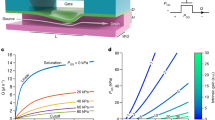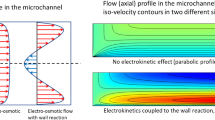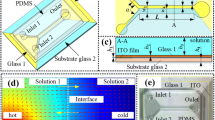Abstract
An adjustable diffusion-based microfluidic reactor is presented here, which is based on electro-osmotic guiding of reagent samples. The device consists of a laminar flow chamber with two separate reagent inlets. The position and the width of the two sample streams in the flow chamber can be controlled individually by changing the flow ratio of three parallel guiding buffer streams. Since electro-osmotic flow (EOF) is used for pumping, no external pumps or other moving parts are needed. The region where the diffusive profiles of the two sample streams overlap is used for the reactions. This overlapping region can be manipulated in a predictable way by adjusting the voltages required to generate the respective electro-osmotic flow. Reaction dynamics inside the microreactor is illustrated with a reactant pair of a fluorescent calcium tracer and a calcium chloride solution. An analytical model, which is an analogue of electrical circuits to EOF, was developed and embedded into the LabView control software, allowing real-time control of the microreactor. This paper describes the simulation, fabrication and experimental characterisation of the device.









Similar content being viewed by others
References
Ajdari A (2004) Steady flows in networks of microfluidic channels: building on the analogy with electrical circuits. C R Phys 5:539–546
Baroud CN, Okkels F, Ménétrier L, Tabeling P (2003) Reaction–diffusion dynamics: Confrontation between theory and experiment in a microfluidic reactor. Phys Rev E 67:060104
Besselink GAJ, Vulto P, Lammertink RGH, Schlautmann S, van der Berg A, Olthuis W, Engbers GHM, Schasfoort RBM (2004) Electroosmotic guiding of sample flows in a laminar flow chamber. Electrophoresis 25:3705–3711
Brody JP, Yager P, Goldstein RE, Austin RH (1996) Biotechnology at low Reynolds numbers. Biophys J 71:3430–3441
Dittrich PS, Schwille P (2003) An integrated microfluidic system for reaction, high-sensitivity detection, and sorting of fluorescent cells and particles. Anal Chem 75:5767–5774
Fan ZH, Harrison DJ (1994) Micromachining of capillary electrophoresis injectors and separators on glass chips and evaluation of flow at capillary injections. Anal Chem 66:177–184
Fletcher PDI, Haswell SJ, Paunov VN (1999) Theoretical considerations of chemical reactions in micro-reactors operating under electroosmotic and electrophoretic control. Analyst 124:1273–1282
Haswell SJ, Skelton V (2000) Chemical and biochemical microreactors. Trends Analy Chem 6:389–395
Haswell SJ, Middleton RJ, O’Sullivan B, Skelton V, Watts P, Styring P (2001) The application of micro reactors to synthetic chemistry. Chem Commun 5:391–398
Knight JB, Vishwanath A, Brody JP, Austin RH (1998) Hydrodynamic focusing on a silicon chip: mixing nanoliters in microseconds. Phys Rev Lett 80:3863–3866
Lee GB, Hwei BH, Huang GR (2001) Micromachined pre-focused M×N flow switches for continuous multi-sample injection. J Micromech Microeng 11:654–661
Lin JY, Fu LM, Yang RJ (2002) Numerical simulation of electrokinetic focusing in microfluidic chips. J Micromech Microeng 12:955–961
Northrup MA, Jensen KF, Harrison DJ (2003) Micro total analysis systems 2003. Kluwer, Dordrecht, The Netherlands
Quiao R, Aluru NR (2002) A compact model for electroosmotic flows in microfluidic devices. J Micromech Microeng 12:625–635
Schasfoort RBM, Schlautmann S, Hendrikse J, van den Berg A (1999) Field effect flow control for microfabricated fluidic networks. Science 286:942–945
Sinton D, Ren L, Li D (2003) A dynamic loading method for controlling on-chip microfluidic sample injection. J Colloid Interface Sci 266:448–456
Song H, Bringer MR, Tice JD, Gerdts CJ, Ismagilov RF (2003) Experimental test of scaling of mixing by chaotic advection in droplets moving through microfluidic channels. Appl Phys Lett 83:4664–4666
Tudos AJ, Besselink GAJ, Schasfoort RBM (2001) Trends in miniaturized total analysis systems for point-of-care testing in clinical chemistry. Lab on a Chip 1:83–95
Weigl BH, Yager P (1997) Silicon-microfabricated diffusion-based optical chemical sensor. Sensors Actuators B 39:425–457
Wensink H, Elwenspoek MC (2002) Reduction of sidewall inclination and blast lag of powder blasted channels. Sensors Actuators A 102:157–164
Yunus K, Marks CB, Fisher AC, Allsopp DWE, Ryan TJ, Dryfe RAW, Hill SS, Roberts EPL, Brennan CM (2002) Hydrodynamic voltammetry in microreactors: multiphase flow. Electrochem Commun 4:579–583
Acknowledgements
The authors would like to acknowledge the funding of this research by the “Netherlands Organization for Scientific Research” (NWO) as a part of the SPRINTLOC “Vernieuwings-impuls” project.
Author information
Authors and Affiliations
Corresponding author
Rights and permissions
About this article
Cite this article
Kohlheyer, D., Besselink, G.A.J., Lammertink, R.G.H. et al. Electro-osmotically controllable multi-flow microreactor. Microfluid Nanofluid 1, 242–248 (2005). https://doi.org/10.1007/s10404-004-0031-6
Received:
Accepted:
Published:
Issue Date:
DOI: https://doi.org/10.1007/s10404-004-0031-6




